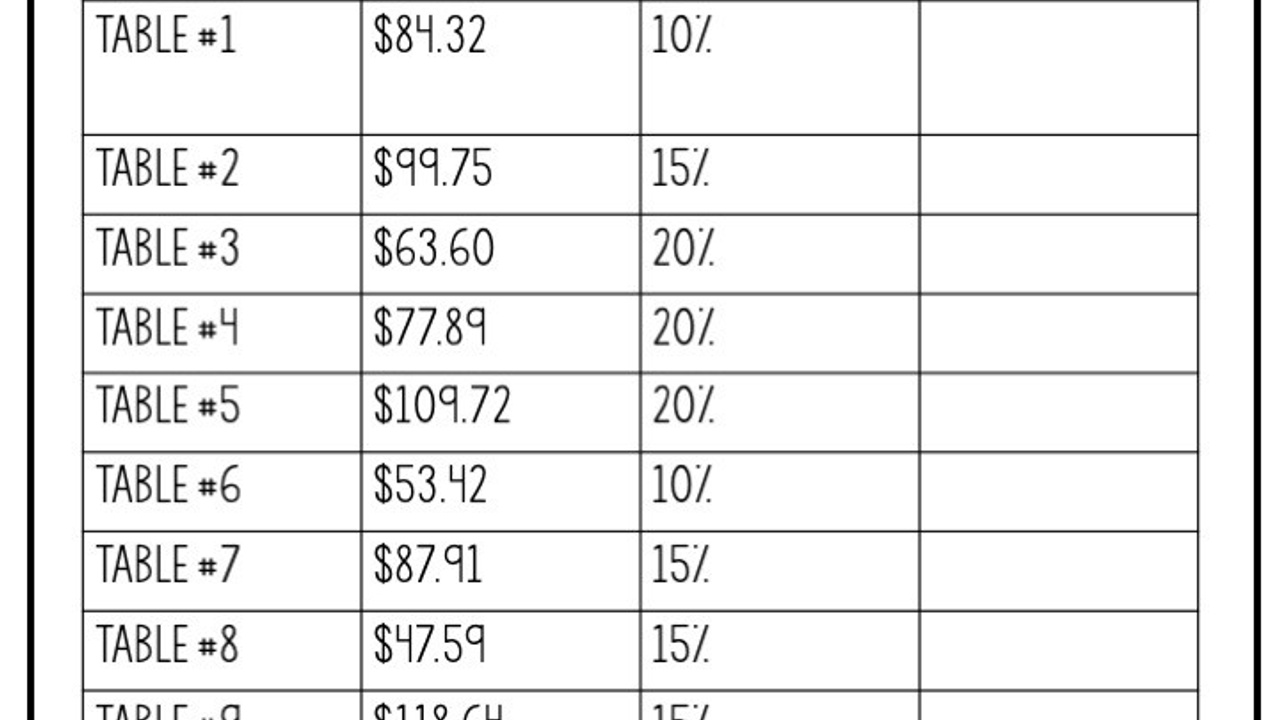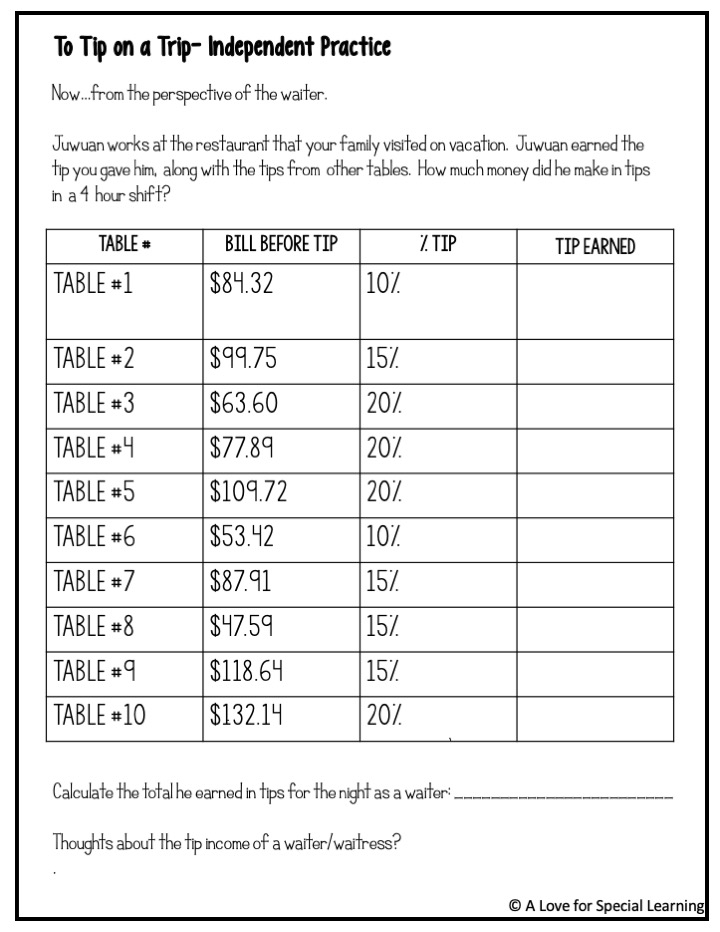How to Teach: Calculate Tip [Special Education Lesson]
Oct 24, 2020
Hey, special education teachers, curious how to teach Tipping to your students with special needs? Read more about why and how you can teach how to Tip to special education students using my Tip Lesson Unit (click here to get your copy).
Purpose of Teaching How to Tip
Showing the workers in the service industry that you/we appreciate their skill, time, and effort is a common thread amongst all 50 states. Being able to calculate that value correctly is a skill, while also providing non-verbal feedback for the service provider.
Key-Must-Teach Concepts
The most important skill to learn is to be kind. Tipping is not a time to be cheap, overlook someone’s extra busy shift or bad days, or to judge someone based on something other than the service and skill they brought to you as a customer. A nice tip in the real world can go a long way for a service provider.
Poor vs Good vs Excellent. Tipping is a subjective sport. However, it is important for students to know how their behavior impacts their service and what a waiter/stylist/etc does and does not have control or power over. This is a great concept to dive deeper into on Day 1, if time allows. Pick 3 highly tip-reliant jobs in your area to focus on, say a rideshare or taxi driver, beautician, and waiter/waitress, and then talk about the type of service you would receive in each scenario.
Tip before Tax. Learning to tip on the subtotal and not the total one sees on the bill is part of the functional math skills that are embedded within tipping. Make it fun to remember, turn it into a jingle you sing before each calculation.
Learning Target/Lesson Objective
Calculate Poor, Good, and Excellent tip values of a given bill.
The Tip Lesson Unit will cut your lesson planning time to almost zero
AND give you age-appropriate classroom activities and instructional practice materials.
Lesson Unit Breakdown
Day 1- Most all of your students will know the term ‘tip,’ but not all will know that it is a percent of a purchase. Since students will have some background knowledge, introducing the concept and the levels of tip (in the Reading Passage) should be smooth sailing.
As mentioned above and below, dissecting the Reading Passage will be worthwhile for your students. Once you’ve described the types of service more thoroughly, then reach for the T/F and Writing prompts.
If time allows, discuss what constitutes a Poor, Good, and Excellent level tip. Again, this is a subjective call, but it is helpful for students to participate in the discussion (you may even change some minds!)
Round out the day with a reference to the visual flow chart and the brain teaser!
Day 2- Per usual, this day is dedicated to absorbing basic concepts through direct instruction and vocabulary through notes. Cover the general Notes and the more detailed key points through the Parts notes worksheets on this day. If time allows or if it can be naturally weaved into the lesson, review the level of service descriptors you made during Day 1. Keep that fresh in your students’ minds as they head into each day’s lesson.
Day 3- I would start this day by reviewing the levels of service (Poor, Good, or Excellent) when being served as a sit-down restaurant. What does each of those service levels look like for the customer AND what % should each receive?
Students can complete the guided practice in small groups, with a partner (preferable), or as part of a whole class walkthrough. The Tipping at a Restaurant worksheet takes students through the most common tipping experience, at a sit-down restaurant. The student will decide on a lunch order from a provided menu, calculate the subtotal, combine their order with a partner’s (can be the person sitting next to them, if it's a whole class activity) draw the level of service (from a teacher’s bin), and then calculate tip for the whole bill.
Day 4- This activity will take the students through the tipping at a restaurant process again and then flip the perspective. The students will then become the waiter/waitress and will calculate the tip % for several bills and identify the take home money from tips for a shift. The waiter/waitress perspective practice is eye opening for some and the constant tip calculating math problems is valuable for everyone- it’s a win win! *Short on time, have your students buddy up and make the last page group work instead of independent work!
Day 5- Review using the task cards (use the fun suggestion below), assess, have students complete the word search and functional math review and call it a day!
Interested in even more special education lesson plans for consumer math concepts? Check out the Consumer Math Curriculum!
Reading Passage Option
The meat of the Reading Passage is the last section where the different levels of service are briefly described. Use the time after the Reading Passage and before the T/F and Writing prompts to carve out what that looks like for different service providers. Start to give students a sense of what it means to receive Poor service at a restaurant, to receive Good service when in a taxi, and Excellent service when getting a haircut. We know that this is a subjective sport, but doing the best you can to get everyone’s mind on the same page will pay dividends later in the lesson week.
Life Skills
If you are looking for more foundational tipping resource, check out my Life Skills Restaurant Paying Lesson unit! It covers tipping and other payment skills and is also appropriate for middle school, transition, and high school students.
Listen and Learn
A Listen & Learn is a short, 5 sentence PowerPoint/Google presentation that introduces the topic using visuals and audio. Ideal for the non-readers in your special education classroom! Read about what they are and how they might be right for your classroom here.
Task Card Idea
If you want to stagger the Around the World system a bit (cards are taped around the room and students move at their own pace answering them), then try this delay method. Call each student up to your desk one at a time (or give them each a problem at their desk at the same time) and have them calculate Subtotal and Service level (Poor, Good, Excellent). Have them calculate the tip and once they get the right answer they can start around the room. This will naturally delay your students and help spread out the number of students working on the same card at the same time.
Further Practice Idea
If you have time during the school year, get them out on a field trip to and enjoy some real worl application at a sit-down restaurant! May I suggest you grab this FREE resource (restaurant project)!
Ultimate Goal of the Lesson Unit
The ultimate goal is for the student to recognize the service they received and tip the proper percent based on their subtotal bill. This is tricky and isn’t something you can easily assess in the classroom, but to reiterate that all service providers DESERVE a tip and should be given at least 10% for their energy and time will go a long way!
May I Also Suggest Teaching
When tipping it’s essential to realize that it is part of a purchase, so subtotal and total are parts of the equation. Therefore, covering Sales Tax and Budget are worthwhile concepts for students to understand before starting this lesson.
























